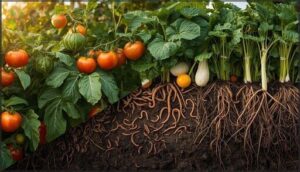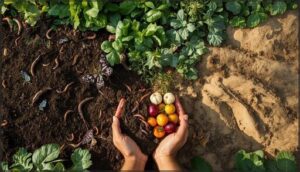This site is supported by our readers. We may earn a commission, at no cost to you, if you purchase through links.
Your tomatoes thrived last year, but this season they’re stunted, yellowing, and riddled with blight. The soil hasn’t changed—or has it? Planting the same crops in the same spots year after year quietly drains specific nutrients while pest populations explode and diseases take permanent residence.
Crop rotation breaks this cycle, and the numbers back it up: rotating your plantings can boost soil fertility by up to 40%, slash pest pressure in half, and increase your overall harvest by 20% or more. The benefits of crop rotation gardening extend far beyond a single growing season—they transform how your garden sustains itself.
Table Of Contents
Key Takeaways
- Crop rotation boosts soil fertility by up to 40% and increases overall harvest yields by 20% or more by strategically cycling plant families that naturally replenish nutrients—legumes add nitrogen, deep-rooted crops break compaction, and diverse rotations enhance microbial activity without synthetic fertilizers.
- Moving crops between beds slashes pest and disease pressure by 55-75% because it disrupts specialist insects and soil-borne pathogens that depend on the same host plants year after year, cutting pesticide use in half while attracting beneficial predators naturally.
- A simple three- to four-year rotation plan—grouping crops by family and alternating heavy feeders with light feeders—prevents nutrient depletion, reduces fertilizer costs by 41-46%, and works even in small gardens or containers with smart space management.
- Beyond immediate yields, crop rotation cuts soil erosion by 60%, reduces agricultural runoff by 55%, and builds climate resilience by lowering drought-related losses up to 90%—making your garden both more productive and environmentally sustainable.
How Crop Rotation Improves Soil Health
If you want a thriving garden, you need to start with healthy soil—and that’s where crop rotation really shines. Moving your crops around each season doesn’t just prevent problems; it actively rebuilds and enriches the ground beneath your feet.
Let’s look at four key ways this practice transforms your soil into a powerhouse for plant growth.
Enhancing Soil Fertility and Nutrient Balance
Fertility management through crop rotation isn’t just about avoiding nutrient depletion—it’s your ticket to building genuinely rich soil. When you rotate crops strategically, you’re tapping into natural nutrient cycling that synthetic fertilizers can’t match:
- Legumes boost soil nitrogen by 20–40% compared to planting the same crop repeatedly
- Cereals following legumes need 41–46% less synthetic nitrogen while maintaining strong yields
- Rotating crops with varied root systems enhances phosphorus and potassium availability for heavy feeders
- Diverse rotations stimulate microbial balance, unlocking nutrients through enhanced microbial activity
This approach transforms soil management from a constant battle into a self-sustaining cycle where each crop readies the ground for what follows. By understanding soil fertility management, farmers can refine their crop rotation strategies for better yields.
Increasing Organic Matter and Soil Structure
Beyond adding nutrients, crop rotation transforms your soil’s physical architecture. Diverse rotations increase organic matter by 6.5% and boost aggregate stability by up to 35%, creating soil that breathes and holds water better.
Deep-rooted crops like brassicas break up compaction, while legumes feed microbial activity that cements particles into stable aggregates. This living structure—higher in soil carbon and teeming with beneficial organisms—turns dirt into real soil health.
By adopting crop rotation practices, farmers can improve soil fertility management and ultimately improve their soil’s overall health.
Reducing Soil Erosion and Compaction
Crop rotation doesn’t just feed your soil—it protects it. Strategic rotations slash soil erosion by up to 91% in vulnerable areas and ease soil compaction through deep-rooted crops that create natural aeration channels.
This soil stabilization translates to better water infiltration and stronger erosion control. You’ll see six more inches of topsoil retained over time, proving that smart crop rotation is real soil conservation in action.
Promoting Beneficial Soil Microorganisms
Protecting your topsoil is one thing—bringing it to life is another. Crop rotation boosts microbial biomass carbon by 13.4% and increases soil biota richness by 15%, transforming soil health from the ground up.
You’ll see stronger fungal networks, improved bacterial balance, and enhanced nitrogen fixation. These ecosystem services drive soil microbial activity that powers nutrient cycling and soil conservation—proof that diversity underground produces outcomes above it.
Managing Pests and Diseases With Crop Rotation
One of the most frustrating parts of gardening is watching pests and diseases take down your hard work season after season. The good news is that crop rotation naturally disrupts these cycles, giving you an edge without reaching for synthetic chemicals.
Let’s look at how moving your crops around can help you stay ahead of garden threats and build a healthier, more resilient growing space.
Breaking Pest and Disease Cycles
When you move crops around each season, you’re basically pulling the rug out from under pests and diseases that depend on the same host year after year. Crop rotation disrupts pest cycles by denying specialist insects their preferred food—fields rotated between corn and soybeans see pest populations drop by 55-70%.
Disease suppression follows the same logic: soil-borne pathogens lose their hosts, protecting your crop diversity and microbial balance naturally.
Reducing Need for Chemical Pesticides
Rotating your crops slashes pesticide use in a dramatic way—field trials show reductions up to 50% through integrated pest management built on rotation.
You’ll see organic methods and sustainable farming work hand in hand: maize-soybean sequences cut rootworm pesticide needs by more than half, while rice rotations dropped applications by 39%.
That’s real pest control without the chemical load, protecting both soil health and your wallet.
Attracting Natural Predators and Beneficial Insects
Diversifying what you grow transforms your garden into a sanctuary for beneficial arthropods and pollinator support. When you switch crops strategically, you boost predator attraction and insect conservation in powerful ways:
- Doubling crop diversity increases pest seed predation rates by 16% through enhanced beneficial insects activity
- Cover crop mixtures with clovers markedly improve wild bee visitation and biodiversity enhancement
- Flower strips raise natural enemy numbers by 70%, strengthening pest management
- Heterogeneous rotations maintain ecosystem health while supporting soil health and year-round biodiversity
Minimizing Soil-borne Disease Buildup
You can slash soil-borne pathogen threats by up to 75% when you rotate your crops strategically. Disease suppression happens because you’re interrupting pathogen control cycles—those pesky fungi and bacteria can’t establish permanent headquarters in your soil.
Crop diversity enhances microbial balance, boosting beneficial organisms that fight plant diseases naturally. Three-year rotations outperform two-year cycles for disease prevention, giving your soil health the upper hand against recurring infections.
Boosting Garden Yields and Productivity
You’ve built healthier soil and cut down on pests—now it’s time to see the payoff in your harvests. Crop rotation doesn’t just protect your garden; it actually boosts how much you can grow and how well your plants perform.
Let’s look at the specific ways rotating crops translates into bigger, better yields.
Optimizing Plant Nutrient Uptake
When you rotate crops by plant families, you discover a hidden advantage: each species accesses different soil nutrients at varying root depths. Legumes fix nitrogen, while brassicas scavenge leftover nutrients with deep taproots, and this crop sequencing boosts fertilizer efficiency by 25% or more.
Meanwhile, diverse roots feed soil microbes that cycle nutrients back to your plants—transforming soil health into a self-renewing system that cuts costs and maximizes every harvest.
Supporting Diverse Crop Growth
You can’t squeeze a thriving garden from tired soil—but crop rotation unlocks biodiversity conservation by supporting 15–35% more viable species than monoculture.
When you sequence legumes, cereals, and cover crops across four years, soil organic matter climbs 1.2% annually, fueling nutrient cycling and ecosystem balance.
That diversity cuts drought losses up to 90%, proving soil resilience and crop diversity aren’t buzzwords—they’re your blueprint for unstoppable growth.
Crop diversity can slash drought losses by up to 90 percent, proving soil resilience is your blueprint for unstoppable growth
Increasing Overall Harvests
When you roll out a well-planned rotation, agricultural efficiency skyrockets—harvests jump 20% on average compared to monoculture. Legume-inclusive sequences boost that to 23%, lifting farm output increase through smarter soil productivity and harvest optimization.
Global trials spanning four decades prove crop yield management through rotation isn’t wishful thinking—it’s how you claim bigger, more reliable yields while keeping ecological balance and sustainable gardening on track.
Balancing Heavy and Light Feeders
Here’s the secret to nutrient management: alternate heavy feeders like tomatoes with light feeders such as carrots. This crop rotation strategy prevents nutrient depletion while boosting soil nutrient cycling by up to 22% in nitrogen alone.
Smart feeder crop management through crop diversity strategies can cut your fertilizer use by 41%—that’s real money saved and healthier soil for seasons ahead.
Environmental and Economic Benefits
Crop rotation doesn’t just benefit your plants and soil—it also lightens the load on your wallet and the planet. By reducing your reliance on synthetic inputs and minimizing environmental harm, you’re practicing gardening that pays off in more ways than one.
Here’s how rotating your crops can support both your budget and a healthier ecosystem.
Lowering Fertilizer and Pesticide Costs
You’ll see real cost savings when you adopt crop rotation. By cycling cereals with legumes, you can cut synthetic fertilizer use by roughly 41%–46% while keeping yields steady. Studies show fertilizer reduction from 80 kg down to just 11 kg per hectare in diverse rotations.
Pesticide minimization happens naturally—improved soil health and natural pest control mean fewer chemical inputs, directly boosting your bottom line through smart input optimization.
Reducing Agricultural Runoff and Pollution
Beyond saving money, your crop rotation work directly fights water pollution and protects the land. This environmental sustainability practice slashes nitrate runoff by 55% and cuts soil erosion by up to 60%, safeguarding nearby streams and aquifers.
Your soil conservation efforts through smart fertilizer management and erosion control mean:
- Cleaner drinking water for your community
- Healthier aquatic ecosystems downstream
- Reduced chemical contamination in groundwater
- Protected topsoil for future generations
- Lower greenhouse gas emissions from your garden
That’s water conservation and soil health working hand-in-hand.
Supporting Sustainable Farming Practices
When you adopt crop rotation, you’re tapping into agricultural sustainability that boosts farm income by 20% while championing environmental stewardship. These sustainable methods slash synthetic fertilizer use by 3.6 million tonnes globally.
Your green initiatives create win-win relationships—yield, nutrition, and revenue jump 14–27% compared to monoculture. That’s eco-friendly crop rotation making sustainable agriculture and ecological farming truly pay off.
Increasing Resilience to Climate Challenges
Under Climate Change, your Crop Rotation strategy unlocks powerful Climate Adaptation through Weather Resilience and Drought Tolerance. Diversified systems cut drought-related yield losses by 18% while raising water use efficiency to over 10.5 kg per hectare-millimeter.
Enhanced Soil Health delivers Carbon Sequestration and critical Ecosystem Services, slashing greenhouse gas emissions by 40%. That’s Agricultural Sustainability securing your harvests against tomorrow’s unpredictable weather.
Practical Tips for Successful Crop Rotation
You don’t need a degree in agronomy to put crop rotation into practice—just a little planning and the willingness to experiment. The key is working with what you’ve got, whether that’s a sprawling plot or a handful of raised beds.
Here are some straightforward strategies to help you design a rotation that actually works for your garden.
Planning Rotations by Plant Family
Grouping crops by botanical classification is your roadmap to successful rotation. You’ll want to organize plant families—legumes, brassicas, nightshades—into separate beds, then rotate them through a three- to four-year cycle.
This family grouping prevents disease buildup and aids soil restoration. By respecting crop sequencing and garden diversity, you’re working with nature’s rhythm, not against it.
Using Records and Garden Planners
Your garden records are the unsung heroes of successful crop rotation. Whether you prefer a simple logbook or digital planning tools, tracking what grows where each season prevents costly mistakes.
Garden mapping helps you visualize crop tracking across garden beds, while record analysis reveals patterns in soil health over time. Soil monitoring notes guide smarter decisions, and studies show detailed garden planning can boost yields by 15%.
Adapting Crop Rotation for Small Gardens
Think crop rotation won’t work in your small vegetable garden? Think again. Even beds under 20 square meters can benefit when you group plants by family and rotate blocks rather than individual crops. This approach cuts garden planning time by half while keeping soil health on track.
- Use Small Plot Strategies by dividing space into 3–4 family blocks
- Apply Urban Gardening Tips like moving containers seasonally to mimic rotation
- Try Container Rotation with legumes in 20–30% of pots yearly
- Combine Vertical Farming with Intensive Cropping, alternating shallow and deep-rooted crops
Choosing Effective Crop Rotation Sequences
Your rotation planning starts with one simple rule: keep at least three years between planting the same crop rotation families in the same bed. Family grouping matters because Solanaceae, Brassicaceae, and legumes share specific pests.
For sequence optimization, follow legumes with heavy feeders like brassicas—they’ll thrive on residual nitrogen. A basic crop sequence might run beans, tomatoes, brassicas, then onions.
Soil analysis helps fine-tune your approach, but rotating crops by plant families delivers the core benefits of crop rotation every season.
Frequently Asked Questions (FAQs)
How long should a crop rotation cycle last?
Like tuning an instrument for perfect pitch, most gardens hit their sweet spot with a three- to four-year crop rotation cycle, giving soil time to recover while maximizing yields and interrupting pest cycles effectively.
Can crop rotation work in container gardens?
Yes, you can rotate crops in containers by switching plant families each season. This practice improves soil health, reduces garden pests, and boosts yields—just like in traditional vegetable gardens, with smart space optimization.
What crops are best for beginner gardeners?
Beginner plants like radishes, lettuce, and snap beans deliver fast growing results—often under 30 days.
These easy vegetables thrive in simple harvest systems and naturally support soil health when you start exploring crop rotation gardening techniques.
Does crop rotation help with water conservation?
Picture a garden where the soil stays moist longer between watering.
Crop rotation boosts water retention by up to 20%, enhances irrigation efficiency, and strengthens drought tolerance—all while improving soil moisture levels naturally.
When should I plant cover crops during rotation?
Plant cover crops in fall—late August through October in most regions—right after harvesting your main crop. Spring plantings work too, but you’ll get less biomass. Terminate them at least two weeks before planting your next rotation.
Conclusion
Next spring, picture your garden thriving where it once struggled—tomatoes vigorous, pests scarce, soil dark and alive. That transformation starts with a simple rotation plan today.
The benefits of crop rotation gardening compound season after season, turning depleted ground into self-renewing fertility. You’re not just growing vegetables; you’re building an ecosystem that works harder while you work smarter.
Break the cycle now, and watch your garden break free.
- https://www.nature.com/articles/s41467-023-44464-9
- https://www.nal.usda.gov/exhibits/ipd/carver/exhibits/show/soil/item/116
- https://farmonaut.com/blogs/soil-rotation-crop-rotation-garden-5-key-benefits-2026
- https://www.frontiersin.org/journals/sustainable-food-systems/articles/10.3389/fsufs.2021.647335/full
- https://www.ars.usda.gov/news-events/news/research-news/2024/diverse-crop-rotations-reduce-risk-of-crop-loss-under-poor-growing-conditions/












